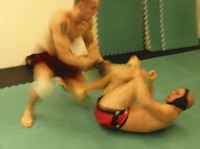
We’ve talked about solo drills and partner drills. There is a final category of drills I’d like to talk about: competitive 2 person drills.
When you do this type of drilling you are training a specific aspect of your game against a resisting opponent. Essentially you are severely limiting the options available to you and your partner, and from this limitation comes refinement of existing techniques and innovation of new techniques.
The aspect that you are working on could be very general (e.g. passing the open guard) or very specific (e.g. getting a certain grip or maintaining a certain kind of posture). The level of resistance that you opponent/partner gives you can vary from about 10% to full out 100% sparring.
This definition of drilling leads to a truly staggering number of possible drills. The best thing for you to do is to try to develop various drills that will develop your game. Consider the process of taking someone’s back and submitting him. If this was an area that you wanted to develop, then here are some of drills you might want to experiment with. Depending on what your strengths, weaknesses and strategies are you may end up retaining some of these drills for a while, in order to hone your ability to attack the back. All these drills start with your partner in the turtle and you on top of him – your goals, however, vary from drill to drill.
- He tries to put you in the guard, you try to keep him turtled using your bodyweight and moving around him
- Your goal is to obtain your favorite grip, be it linked hands under-over, double lapel grips through his armpits, or whatever your favorite control grip is. You restart in the same position if you get your grip, or if he puts you in the guard, or if he stands up, or if he rolls you.
- Your goal is to get both hooks in – restart if you succeed or if he escapes to a safe position.
- Start with one hook in: your goal is to insert the second hook. His goal is to remove your hook and to prevent the second hook. Go for a defined time period (e.g. 2 minutes) and then switch positions.
- Your goal is to keep the back and submit him: restart if you submit him from rearmount, or if he escapes, or even if you end up pinning him in any other position than with your chest on his back.
- etc.
- etc.
- etc.
This is just scratching the surface, and you should now be able to see that you could do similar drills for virtually every position and every submission. All it takes is some honesty and perception on your part to know what your weaknesses are, and some inventiveness to create the drill(s) to fix that weakness.
This sort of drilling is very similar to what I call ‘targeted sparring’. For more information on targeted sparring check out these other tips of the week’:
- Targeted Sparring: Mobility
- Targeted sparring: Position
- Targeted Sparring: Limited Technique
- Targeted Sparring: Bad Positions


